“Everybody has stories.”—Mary, Upstander
Why this Book? Why will it matter to kids?
Upstander, a 2021 Junior Library Guild Selection, is a thought-provoking middle-grade novel that approaches substance use disorder, bullying, and family dynamics head-on in a plot that keeps readers turning the page. The story is unflinching but ultimately hopeful. The characters, many of whom readers will have met in Bystander, are authentic. Their flaws feel organic, and their struggles real. We see humanity at its best in the actions of the central characters as they yearn to understand the world and endeavor to grow into empathetic, caring human beings.
Levels and Layers of Learning
Using This Book in the Classroom
Hit the Ground Running Ready Resources for Educators, Homeschoolers, and Parents
James Preller reads from the first pages of Upstander.
Read student reactions to Bystander, the companion to Upstander.
Write Away! Ideas to prompt writing
In Writing Workshops I conduct with middle and high school students, I use, along with other novels and informational books, one of the early scenes in Bystander to demonstrate imagery and sensory description. In a conversation I had with the author, he said, “With Upstander, and others, there are always scenes, moments, passages, sometimes entire chapters that feel right. Where I can say, okay, that was good right there.” Write about one scene, moment, passage, or chapter in Upstander that you feel “was good right there.” Explain why your chose that passage. (Find the author’s choices in the interview below.)
Choose a scene in Upstander that gives the reader insight into one of the character’s actions. Explain how the scene alters your understanding of and feelings about the character.
In one of James Preller’s blog posts he quotes Neil Gaiman: “Fiction gives us empathy: it puts us inside the minds of other people, giving us the gifts of seeing the world through their eyes. Fiction is a lie that tells us true things, over and over.” In Upstander we see the world through Mary’s eyes. What true things does her story tell?
In another blog post: “A Battle You Know Nothing About” (Can you tell I think James Preller’s blog is AWESOME?) James offers a photograph of Robin Williams and quotes him: “Everyone you meet is fighting a battle you know nothing about. Be kind. Always.” Of the quotation James says this: “This idea…was one of the prime motivating factors in telling Mary’s story in Upstander. The sense that we never know what people are going through in their private lives. Be gentle with others, try not to judge too harshly.” Respond to this, reflecting and drawing upon personal experience.
The main character in Bystander who also plays a part in Upstander is Griffin, a bully with a flair for manipulation. In discussing this character, the author says, “Bullying is a behavior, it’s not the definition of a person. As Bryan Stevenson says, ‘I’ve come to understand and to believe that each of us is more than the worst thing we’ve ever done.'” Reflect on Griffin’s character, the author’s opinion on bullying, the quote, and the title of the books. Offer your viewpoint, based on personal experience.
Poetry Break Related poetry to recite before or following the reading of this book
Poetry breaks fit perfectly into brief moments in the day—from opening or closing the day to lining up for lunch; from zipping up backpacks to transitioning from one subject to the next. Reading a poem typically takes less than a minute, yet it can introduce or reinforce a concept, celebrate language, exemplify rhythm, enhance vocabulary, expand understanding, increase attention span, initiate reflection, or summon a giggle. And, poetry soothes the spirit.
“Poems, Pictures, and Primary Sources” written by high school librarian Rebecca Newland in School Library Journal (May 23, 2021) offers suggestions for pairing photographic images and poetry to engage students by offering glimpses into varied experiences, some of which may be unfamiliar and others that may represent more familiar scenes. Resources and suggested activities from writing prompts to discussion points round out this informative article.
And Then There’s This…
Enrichment activities, related books, online resources, craft projects, and ideas for further study
“An Author’s Guide to Simultaneously Reading Bystander and Upstander“
Notable Books About Substance Use Disorder Recommended by James Preller
- Saving Jake: When Addiction Hits Home by D’Anne Burwell
- The Joey Song: A Mother’s Story of Her Son’s Addiction by Sandra Swenson
- Addict in the Family: Stories of Loss, Hope, and Recovery by Beverly Conyers
- Beyond Addiction: How Science and Kindness Help People Change by Jeffrey Foote, Carrie Wilkins, and Nicole Kosanke with Stephanie Higgs
- Beautiful Boy: A Father’s Journey Through His Son’s Addictions by David Sheff
- If You Love Me: A Mother’s Journey Through Her Daughter’s Opiod Addiction by Maureen Cavanagh
Meet the Author
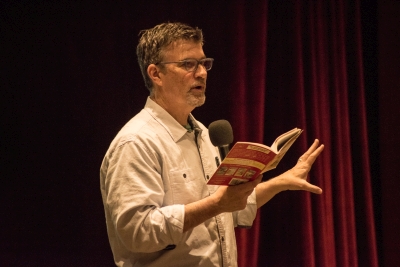
Backstory: Q & A with James Preller
Judy Bradbury: Upstander is creatively part prequel/ part sequel to your previous novel, Bystander. Explain how you came to the idea of it.
James Preller: On school visits, I’ve been asked to write a sequel hundreds of times. Students usually want to know what happens next to their favorite characters. I was content that a question lingered in their minds. It wasn’t until it occurred to me that I could write an overlapping story—larger, not longer—that it clicked for me. I saw how I could do it. 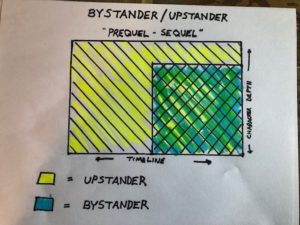
Intersecting Timelines for Bystander and Upstander
JB: How did you decide on the title?
JP: With Bystander, I was fortunate to write one of the first realistic middle-grade books on bullying. I stumbled upon the right topic at the right time. That book got a lot of attention and was often a “one book/one school” selection. Which is a mind-blowing honor. On visits, I kept coming across that idea, often expressed as a poster in the halls: “Be an upstander!” Anti-bullying, when it becomes too strident, can become a negative message. Many schools opted to emphasize the positive: kindness and community. I am 100% behind that initiative. Thus, Upstander.
JB: Tell about one hurdle you experienced in the creation of Upstander or provide a memorable (or humorous!) anecdote related to the making of this book.
JP: What happens frequently for me is that I’ll have an idea for a book, then I’ll soon realize that I’m not nearly smart enough to write it. A lot of loose ends fell together when I reached out to Young Do, an executive director who operates a care and substance use treatment facility, Hospitality House, in Albany, NY. Young became a generous source of insight and information. In fact, the opening of the book grew directly from a personal story that Young shared about his own experiences with his brother. He told me a story and I thought, “Oh, that’s how the book begins!”
JB: What did you learn from writing Upstander?
JP: I think my compassion for everyone concerned— friends and family members—deepened significantly. The more I learned, the more empathy I felt. I read a lot of powerful books, too. (See list above in “And Then There’s This.”)
JB: What would surprise readers to learn about you or about the writing of Upstander?
JP: Because the books intersect, I spent a lot of time with a big fat calendar, figuring out the timeline by rereading Bystander and working backwards. It was very much like putting a puzzle together. It involved math.
JB: One of the themes in both Bystander and Upstander is that we are all dealing with something that tests our being, our will, or our best intentions. A person’s actions and reactions rarely are surface: they result from somewhere deeper. How did you come to the way this theme plays out in Upstander?
JP: That was a core concept for the book: everyone has a story. We see surfaces—especially on social media—but we have no idea what others are experiencing in their private lives. A sick mother, financial problems, family conflicts, anxiety, any number of “invisible” stressors. There’s a lot that we don’t talk about. And because of that, we need to be less in a hurry to judge others.
JB: Kindness, compassion, and hope are woven throughout Upstander in the main characters’ actions, thoughts, and even in their missteps. Griffin, introduced in Bystander, is not a likeable kid. Readers get further insight into his character in Upstander. Mary, like Eric also a character first introduced in Bystander, demonstrates an earnest desire to do better and to help, though she fails at times. How did you determine how to flesh out these strong, authentic characters?
JP: Well, that’s the goal in a novel — full, well-rounded, complex characters. Walt Whitman’s “I am large, I contain multitudes.” The missteps are what reveal our humanity. The last thing I want is a “perfect” character. Or, for that matter, a consistently “bad” character. 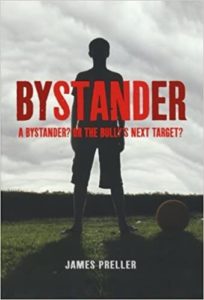
JB: We see Jonny’s struggles with substance use mainly through Mary’s eyes. We witness how his substance use disorder affects those who love him. How did Jonny’s character develop as you wrote this story?
JP: I am the youngest of seven children, twelve years younger than my oldest brother, Neal, who died of AIDS-related illness in 1993. I have clear memories of a being a little boy, watching the goings-on in a busy, crowded household. Some things I understood, most I didn’t fully grasp. So with Mary, though she’s bright and perceptive, she doesn’t know exactly what her brother does and where he goes. That wasn’t the purview of the book. But Mary did know how it affected their home. In developing Jonny, I held closely to Mary’s sense of him. So many younger sisters love (admire, respect) their older brothers. That was the point of departure, this closeness they once shared . . . a relationship that was crumbling before their eyes because of his substance use disorder.
JB: In a conversation we had, you said, “I was asked about books recently, how I feel about them, the excitement factor, and I guess I’m pretty guarded by now. With Upstander, and others, there are always scenes, moments, passages, sometimes entire chapters that feel right. Where I can say, okay, that was good right there.” What is one scene, moment, passage, or chapter in Upstander that gave you that feeling?
JP: There are a number of scenes toward the end of Upstander that I feel good about. The moment between Mary and Ernesto. The note from Mary’s mother: I see you. The conversation with Griffin in the woods. Even Officer Goldsworthy’s words at the bike racks: the way that very minor character stepped forth. And that he’s a good, caring police officer. But I have to say, I really like the Narcan scene, Jonny recounting Vivian’s overdose.
JB: What do you hope readers will take away from Upstander?
JP: I want readers to enjoy the story, to enjoy a positive reading experience. What they get out of it is up to them. But, sure, one thing I tried to put into the story was to put a human face on the so-called “drug addict” and the suffering that comes from this horrible illness.
JB: How do you see Upstander connecting to curriculum?
JP: I leave that up to the educators. Upstander is a book about real life — real things that happen in communities everywhere. One hopes that fits in somewhere.
JB: What is one question you wish I had asked, and what is your answer?
JP: Hmmm, okay: Yes, I did enjoy returning to these characters that I had thought I’d left behind. I especially liked fleshing out some of the minor characters from Bystander: Hakeem, Chantel, and Mary, of course. If I were to do a sequel to the sequel? I’d tell Griffin’s story. He’s the “bully,” the bad guy, but I feel tremendous sympathy for him. The struggle is real. Bullying is a behavior, it’s not the definition of a person. As Bryan Stevenson says, “I’ve come to understand and to believe that each of us is more than the worst thing we’ve ever done.”
JB: What’s up next?
JP: I am writing a book about a 7th-grade soccer star who suffers from the lingering effects of a concussion and struggles to reinvent herself. But once again, coming full circle, I find myself in the same old place: I don’t know enough to write it! Not yet, anyway. I’m working on it.
About the Cover
Over to You…
What recently published contemporary middle-grade novel do you recommend?
Thanks for sharing!
News & Updates
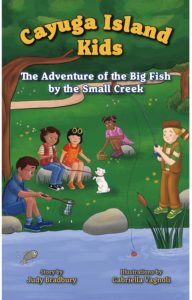 In September, the second book in my CAYUGA ISLAND KIDS chapter book series will be available! Intended for ages 7-10/ Grades 1-3, Book 2: The Adventure of the Big Fish by the Small Creek centers on recycling, and the value of looking in a new direction when stuck on a problem. This fiction series about five contemporary kids offers mystery, history, humor, practical age-appropriate research skills, and teamwork, friendship, and SEL themes. PRE-ORDER from the publisher to be entered in a raffle for a reusable water bottle!
In September, the second book in my CAYUGA ISLAND KIDS chapter book series will be available! Intended for ages 7-10/ Grades 1-3, Book 2: The Adventure of the Big Fish by the Small Creek centers on recycling, and the value of looking in a new direction when stuck on a problem. This fiction series about five contemporary kids offers mystery, history, humor, practical age-appropriate research skills, and teamwork, friendship, and SEL themes. PRE-ORDER from the publisher to be entered in a raffle for a reusable water bottle!
Educators: Limited digital ARCs are available to educators interested in reviewing CAYUGA ISLAND KIDS Book 2, The Adventure of the Big Fish by the Small Creek. An extensive Educator Guide featuring cross-curricular activities aligned to CCSS and activity sheets will be available free for download on my website. Contact me for more information.
Find information on my upcoming events!
ReadWriteThink, powered by NCTE, has been updated.
Final Thought
“I have come to believe, more than ever, that unfailing kindness and love and connection are essential elements for successful recovery. At least, I think that’s the best place to start–with an open, fragile, resilient heart. And never, ever give up hope.”—James Preller, Author ‘s Note, Upstander

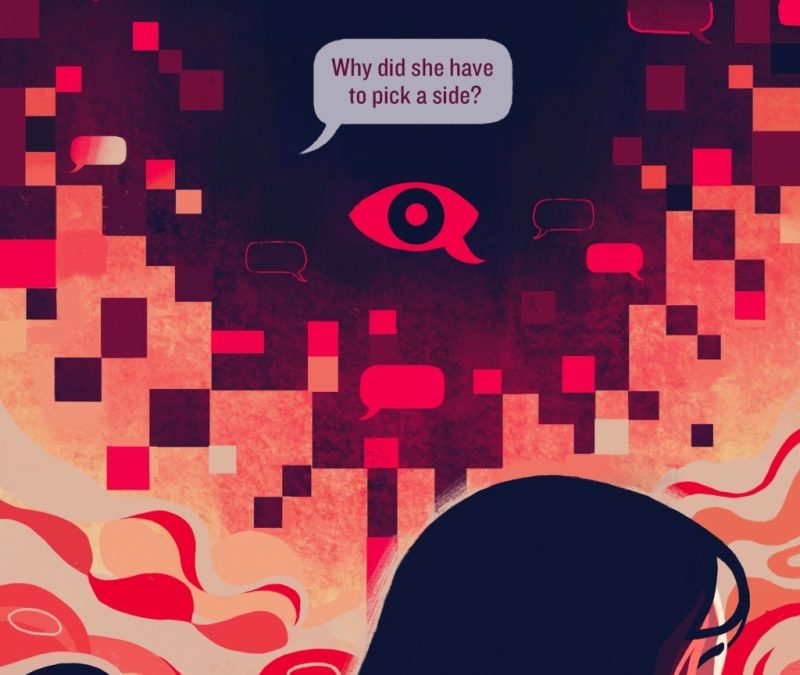
Fantastic, Judy! So many authors I admire!!! Congratulations on your new book!
The interview with James Preller, one of my favorite humans and writers, is worth re-reading over and over. Thank you.!
Hi Robin! Thank you for your kind words. I’m glad you enjoyed the interview with Jimmy. He’s busy at work on a new novel and a series, so stay tuned!